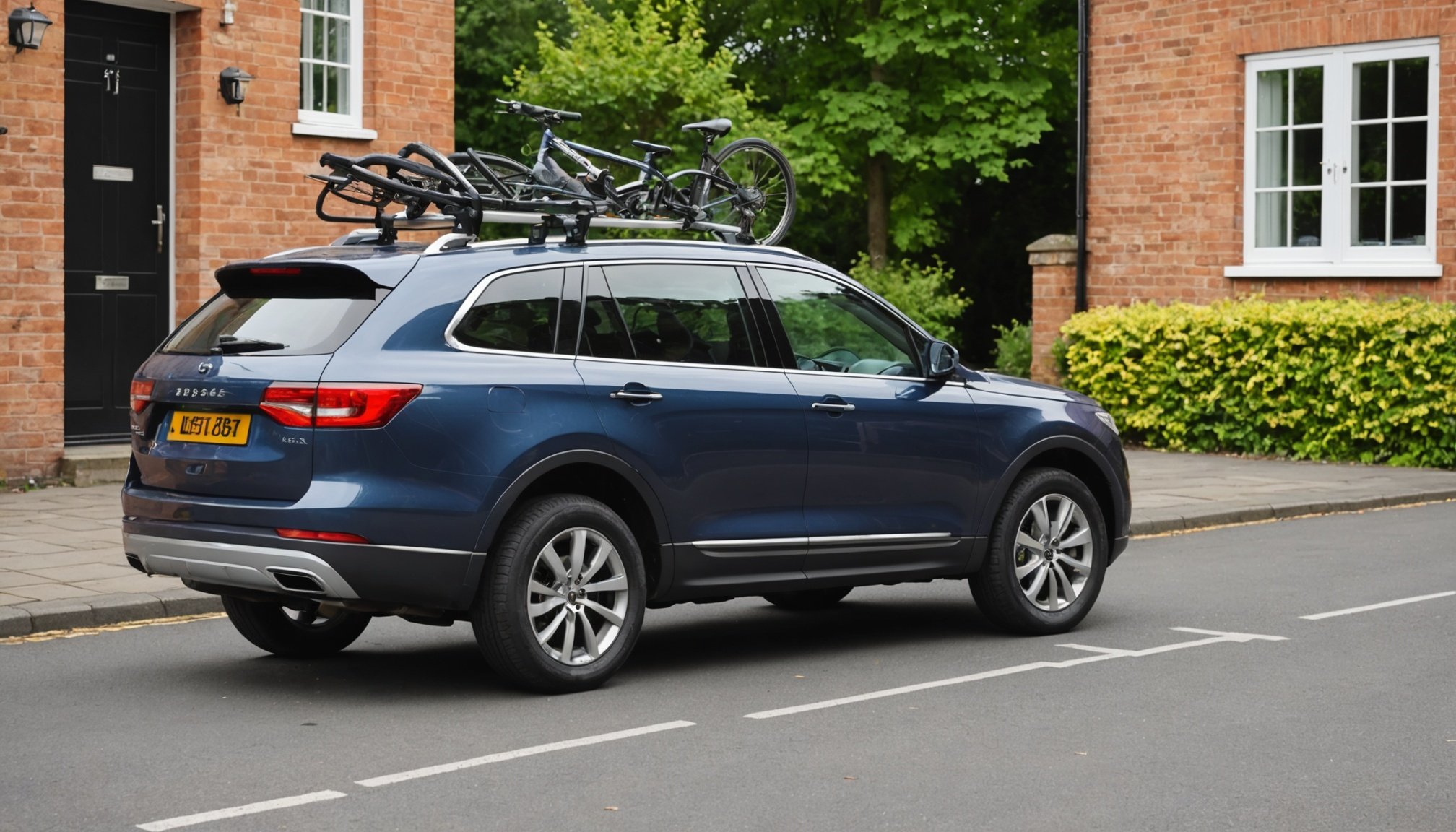Introduction to Roof-Mounted Bike Racks
Roof-mounted bike racks are a popular choice among cycling enthusiasts due to their ability to securely transport bicycles while maintaining access to the vehicle’s boot and rear doors. One of the primary reasons to opt for these racks is their versatility. They can accommodate various bike sizes and types without impeding sight lines or access.
The benefits of using a roof-mounted bike rack extend to safety and stability while driving. With the bikes positioned on the roof, there is a reduced chance of them blocking rear visibility, which is essential for a safe driving experience. However, it’s crucial that the vehicle’s roof specifications and weight limits are checked to ensure compatibility with the chosen rack.
Also read : Unlocking the secrets: a comprehensive step-by-step guide to legally converting your uk petrol car to lpg!
In comparison to other bike rack types, such as trunk-mounted or hitch-mounted racks, roof racks offer several advantages. They do not interfere with a vehicle’s rear access or risk covering license plates and lights. Moreover, roof racks are often seen as more durable and less likely to damage the vehicle than trunk-mounted options. However, they do require lifting bicycles overhead, which might be a consideration based on the user’s physical ability and vehicle height.
Tools and Materials Required for Installation
When preparing to install a roof-mounted bike rack, having the right installation tools and materials is essential for a smooth assembly process. Ensuring that you begin with a comprehensive list of tools eliminates delays and improves safety.
Topic to read : Unlocking carburetor perfection: the ultimate handbook for classic uk car aficionados
Start by assembling essential tools such as a wrench set for securing bolts, a screwdriver for adjustments, and a measuring tape for precise alignment. You will also need protective gloves to enhance grip and protect hands during installation. For materials, ensure you have the necessary brackets and clamps specified by the bike rack manufacturer, which are critical for a secure attachment.
Regarding safety equipment, it’s prudent to have a sturdy ladder to easily access your vehicle’s roof. Additionally, consider using a padded blanket to protect both your vehicle and the bike rack from scratches. The use of non-slip mats can be beneficial for maintaining stability while working at height, especially on an SUV or tall vehicle.
Incorporating these tools and materials not only simplifies the bike rack installation but also increases the integrity of the setup. Ensuring these items are on hand allows for a more efficient installation process, ensuring your focus remains on safely transporting your bikes.
Step-by-Step Installation Guide
Installing a bike rack isn’t as daunting as it might seem. With this detailed guide, you’ll be ready to hit the road in no time.
Preparing the Vehicle
Before diving into the installation process, it’s crucial to ensure your vehicle is ready. Start by confirming the roof’s weight limit and specifications; exceeding this limit may lead to accidents or damage. Clear the roof of any obstructions, such as roof boxes or antennae, to provide a smooth working surface.
Assembling the Bike Rack
Follow a clear, step-by-step assembly process to avoid errors:
- Lay out all components and instructions.
- Assemble the main frame, consulting visual aids for accuracy.
- Secure bolts and screws using appropriate tools to maintain structural integrity.
Common mistakes include misaligning clamps or over-tightening bolts, which can compromise rack stability.
Attaching the Bike Rack to the Vehicle
When securing the rack to your vehicle, use proper techniques for the best fit. Adjust the rack to enhance stability and avoid overloading one side. Once mounted, test the installation by gently shaking the rack; it should remain firm and steady, ensuring bike safety while on the move.
Safety Considerations
Ensuring the safe use of your roof-mounted bike rack is paramount. During installation, adhere to essential safety tips to prevent any mishaps. Start by confirming the secure attachment of the rack. Loose components can lead to accidents. Check all fasteners and ensure they are tightened correctly to keep the rack stable when in use.
A critical aspect of bike rack safety is balancing the load. Uneven weight distribution can affect vehicle handling. Position heavier bikes centrally on the rack to maintain balance. After installation, assess for any unusual vehicle motions to verify stability.
It’s wise to understand the legal considerations in the UK when transporting bikes on your vehicle’s roof. Check local laws to avoid penalties. Many areas require visible registration plates and lights, even with bikes mounted, to ensure road compliance.
Moreover, during transit, continuously monitor the rack and bikes. After long journeys or on rough terrains, reassess the security of the bikes. If you notice wear on the rack or straps, it might be time for a replacement or adjustment. These precautions will enhance both vehicle safety and your peace of mind while driving.
Compatibility with Various Vehicle Types
When selecting roof-mounted bike racks, vehicle compatibility is crucial. Vehicles come with diverse roof types, such as flat, sloped, or even those with factory-installed roof rails. Each design may impact which bike rack is suitable.
For SUVs, the height and roof construction play significant roles. Many SUVs are equipped with roof rails, making them compatible with a range of bike racks. However, it’s essential to consider your vehicle’s height, as lifting bikes onto the roof can be challenging. Hatchbacks, on the other hand, often have less robust roofs but are generally compatible with lightweight bike racks designed to prevent damage.
Sedans typically feature sloped roofs, necessitating careful selection of a compatible rack that won’t obstruct the view or interfere with aerodynamics. Selecting racks specifically designed for sedans may help in aligning with the car’s contours.
To ensure the best fit, measure your vehicle’s roof dimensions meticulously before purchase. Additionally, consulting with the bike rack manufacturer for guidance on compatibility can aid in choosing the ideal system for your specific vehicle. Properly matching the rack to your car enhances security and transportation efficiency.
Securing Bikes on the Roof Rack
Ensuring bike security during transportation is crucial for both safety and peace of mind. Properly securing your bikes prevents movement and potential damage while driving. First, begin by positioning the bikes in an upright manner, which aids in evenly distributing the weight across the roof rack. This arrangement also reduces the risk of swaying or toppling.
Using additional straps and locks significantly enhances security. Straps should be strategically used to tie down all moving parts of your bike, like wheels and handlebars. Ensure each strap is snug but not too tight to avoid applying unnecessary pressure. A secure lock also deters theft, especially when leaving your vehicle unattended for extended periods.
To minimise bike movement, consider investing in specialised stabilising accessories. These accessories can be attached to both the frame and the rack, keeping bikes firmly in place even during vigorous travels or adverse weather conditions.
Finally, conduct a safety check before setting off. Shake the rack lightly to confirm no loose components and adjust as necessary. Regular checks during long trips ensure everything remains secure, providing greater stability and confidence during your journey.
Troubleshooting Common Installation Issues
Ensuring proper installation of a roof-mounted bike rack is crucial for safe transportation. However, common installation issues can arise, testing your patience and skills.
Identifying Common Installation Problems
Several challenges might surface during installation. Misaligned clamps are a frequent problem, often leading to instability. Additionally, bolts not screwing in properly due to incorrect threading can further complicate the process. Another issue is difficulty in adjusting the bike rack to fit the vehicle’s roof specifications.
Solutions to Common Issues
Address these problems with practical solutions:
- Realign clamps by loosening them and following installation guides diligently.
- If screws don’t tighten, ensure they are at the correct angle and that threads are clean.
- For incorrect height or position adjustments, refer to manufacturer guidelines and diagrams.
When to Seek Professional Assistance
Sometimes these issues may persist. It’s wise to consult a professional if:
- The rack remains unstable despite several attempts at correction.
- There are signs of damage, such as bent components.
- You’re unsure about the rack’s compatibility with your vehicle or lack confidence in your adjustments.
Seeking expert help not only ensures security but also provides peace of mind while transporting your bikes.
Resources for Further Assistance
When facing difficulties with roof-mounted bike racks, exploring additional resources can enhance your understanding and skills. These resources often include expert advice, community forums, and instructional videos that provide step-by-step guidance.
Begin by consulting manufacturer websites, which frequently host installation videos showcasing detailed procedures tailored for specific rack models. These videos assist in visualising the correct setup process, helping to avoid common pitfalls in the installation process.
For those seeking specific product insights, expert forums and communities such as Reddit or biking-focused sites allow enthusiasts to exchange troubleshooting tips and personal experiences. Engaging with these communities provides a platform to ask questions, solve unique issues, and receive real-time feedback from seasoned users.
Additionally, several online resources recommend specialised tools and accessories, assisting in both purchase decisions and enhancing rack performance. Known retailers often list these items alongside roof racks, ensuring you have access to vetted options.
For a practical approach, local bike shops also offer expertise that can be invaluable. Their staff often possess firsthand experience with a variety of bike rack types, furnishing personalised advice and guidance.











